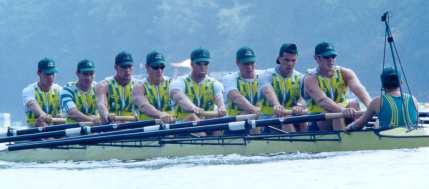ICE JACKETS ARE COOL David T Martina PhD, Allan G Hahn, Rebecca Ryan-Tanner, Kelly Yates, Hamilton Lee, John A Smith Department of Physiology and Applied Nutrition, Australian Institute of Sport, Belconnen 2616, Australia. Corresponding author: dmartin@ausport.gov.au Sportscience 2(4), sportsci.org/jour/9804/dtm.html, 1998 (1791 words)
|
Hot or humid environmental conditions have a negative effect onendurance performance (e.g., Galloway andMaughan, 1997). Any strategies that delay or reduce the increasein body temperature during exercise are therefore likely to enhanceperformance in the heat. In this article we summarize research on theeffectiveness of one of these strategies, pre-event cooling. We alsodiscuss a series of studies completed at the AustralianInstitute of Sport (AIS) that led to the development of a coolingjacket subsequently used by many Australian Olympians during the 1996Summer Olympic Games in Atlanta. Research onPre-cooling The concept of reducing skin or core temperature prior toendurance competition has been investigated since the early 1980s(see review by Booth et al., 1997). Lower skintemperatures enable a greater temperature gradient for dissipatingheat from deeper regions of the body (Schmidt etal., 1981). Cooler skin temperatures mean that less of the totalcardiac output is directed toward the skin, possibly allowing moreblood to be directed to active skeletal muscle. Lower skin and coretemperatures can also delay the onset of sweating and decrease sweatrate, resulting in a conservation of body water during a prolongedcompetitive event (Hessermer et al., 1984).The following published papers form the basis for the currentpre-cooling practices used by athletes prior to competition in theheat. Schmidt and Brück (1981) decreasedcore temperature by 1ºC in 12 well-trained rowers and observedthat the heart rate and sweat rate response to a progressive maximaltest was reduced in the pre-cooled versus the control trial. In thisstudy all subjects rested at 28ºC for 30 min prior to thebicycle test that was performed at 18ºC. Pre-cooling did notaffect maximum oxygen uptake (VO2max) or peakpower output. Hessermer et al. (1984) used a similardesign but incorporated a 60-min maximal cycling time trial for theirperformance test. The eight well-trained rowers improved theiraverage power output by 6.8% when the 60-min time trial was precededby a cold air pre-cooling maneuver that decreased mean skintemperature by 4.5ºC. Myler, Hahn & Tumilty (1989) investigatedthe effects of pre-cooling on the ability of rowers to perform at30ºC and 30% humidity. They found that performance of a 6-minmaximal rowing effort improved significantly: after 5 min of icingthe skin, the rowers traveled 17 meters further in a 6-min all-outrowing test. The increase in power output averaged ~3%. Lee and Haymes (1995) observed improvements inrunning performance following a pre-cooling procedure. Fourteenphysically fit male runners were pre-cooled for 30 min using coldair. After a 10-min transition period, during which skin temperatureswere allowed to warm, subjects ran until exhaustion at 82%VO2max at 24°C. Pre-cooling caused a0.37°C drop in core temperature and an improvement in runningtime from 22.4 to 26.2 min, or 17%. (equivalent to about 1% in anevent). The improved performance was associated with a decreasedsweat rate. Booth et al. (1997) cooled their subjects byabout 0.5ºC using a 20-min cold-water bath. In a subsequent30-min maximal running test in hot humid conditions (32ºC, 62%humidity), maximal 30-min run distance increased by about 2%. Development of the AIS IceJackets Impressed by the potential benefits of pre-cooling on performance,scientists at the Australian Institute of Sport designed a coolingjacket for their athletes. The jacket was made from wet-suit material(Neoprene) and was designed to be packed with ice. In 1996 six womencyclists who were members of the Australian National road cyclingsquad agreed to use the prototype prior to a 25-km individual timetrial held in Queensland, Australia. Not surprisingly, the cyclistsfelt noticeably cooler and upper chest skin temperature was reducedimmediately following removal of the jacket. After the race thecyclists documented their impressions of the ice jacket by completinga questionnaire. Their suggestions were used to modify the jacket forthe next prototype. In collaboration with the Commonwealth Scientific and IndustrialResearch Organization and the University of Sydney, the AIS nextrecruited nine recreational cyclists to complete maximal gradedexercise tests on a bicycle ergometer in a heat chamber at 32ºCand 60% humidity. The first trial was used to familiarize thesubjects to the testing procedure. Subjects then completed either acooling trial or a control trial in a cross-over fashion. For thecooling trial the modified cooling jacket was worn for the first 9min of the protocol (125-175 watts). Subjects cycled for an averageof 1.1 min longer during the cooling trial (332 vs 341 watts).Thermocouples attached to the mid-chest and the mid-back indicatedthat the skin temperature beneath the cooling jacket decreased from32-35ºC down to 10-16ºC by the end of the 9-min period.During the cooling trial perception of effort and perception ofthermal comfort was significantly improved. Despite these differencesin perceptions and skin temperature, the ice jacket did not affectrectal temperature, heart rate, or blood lactate (Smithet al., 1997). For the next study, four female and seven male rowers from theAustralian Defense Force Academy completed two maximal 2000-mlaboratory trials on a Concept IIb rowing ergometer in the AISenvironmental chamber (33ºC, 60% humidity). Prior to the 2000-mtrials, rowers consumed 350 ml of water and completed a 30-minwarm-up at 75% of the power output achieved during a maximal effortfamiliarization trial. Prior to the start of the maximal exercise, anextra 150 ml of water was consumed. For the pre-cooling trial, afinal version Neoprene cooling jacket developed by Neptune Wetsuitswas worn throughout the warm-up period and the rowers were informedthey were drinking water. For the placebo trial red food coloring wasadded to the water and rowers were told they were receiving glycerol,an agent that could aid in hydration and improve performance.Following pre-cooling, average rowing times decreased by 2.8 seconds,or 1.2%. In the cooling jacket trial there was less of an increase incore temperature and lower sweat rates during the warm-up. Followingthe warm-up period, rowers rated their thermal comfort significantlybetter in the pre-cooling trial, and this improved thermal comfortwas also apparent following the 2000-m rowing test. Similarly, theperceived exertion following the rowing test was significantly lower,despite an elevated post exercise blood lactate and a lower bloodpH. The success of pre-cooling suggests that the duration and theintensity of a warm-up should be limited so that core temperature isnot elevated prior to competition. One of the primary advantages of acooling jacket may be that this form of active cooling allows anathlete to experience competition-specific exercise intensity duringthe warm-up without causing a substantial increase in coretemperature. AIS Jackets at the 1996Olympics Feedback from coaches, athletes and sport scientists wasincorporated into the Olympic version of the cooling jacket forAustralian athletes. It was left up to each sport to evaluate rulesto ensure that the ice jacket would not be considered illegal priorto Olympic competition. The proper contacts were made and both Adidas(official Olympic clothing sponsor for Australia) and the AustralianOlympic Committee agreed to support the use of the ice jacket byAustralian Olympians. Once the administrative aspects of the projectwere in order Olympic ice jackets were sent out to track cycling,mountain cycling, road cycling, rowing, canoeing, hockey, and trackand field. Each sport then refined the pre-cooling protocols for useprior to Olympic competition. Approximately 200 green and gold ice jackets bearing theAustralian coat of arms were produced for Olympic athletes travelingto Atlanta. Figure 2 shows some of the rowing team in their jackets.Another 30-40 jackets were produced for Australian athletes competingin the Para-Olympic Games. In all cases athletes were not forced touse the ice jackets. Instead, athletes were made aware of laboratorydata indicating the potential for beneficial effects and then the useof ice jackets was incorporated into practice sessions. Quite simply,many athletes liked the way the jackets felt when training andcompeting in hot conditions.
Evaluation sheets were returned by 43 Olympic athletes and 7Olympic coaches who used the cooling jackets in Atlanta. Athletes andcoaches represented road cycling, mountain cycling, rowing, fieldhockey, and track and field (mostly race walkers). Preliminary dataindicate that 90% of the respondents used the cooling jackets duringtraining sessions and 80% used the cooling jackets as an aid duringOlympic competition. All athletes who used a cooling jacket duringcompetition indicated that it made a positive contribution to theirperformance. Taking into account these comments and previousresearch, we believe that the jackets enhanced the output power ofour athletes by at least a percent or two, depending on the event andthe extent of pre-cooling. Ice jackets will be used increasingly incompetitions held under hot conditions. References Booth, J., Marino, F. & Ward, J.J. (1997).Improved running performance in hot humid conditions following wholebody pre-cooling. Medicine and Science in Sports and Exercise, 29,943-949. Galloway, S.D.R. & Maughan, R.J. (1997).Effects of ambient temperature on the capacity to perform prolongedcycle exercise in man. Medicine and Science in Sports and Exercise,29, 1240-1249 Hessermer V, Langusch D, Brück K,Bödeker RH, Breidenbach T (1984). Effect of slightly loweredbody temperatures on endurance performance in humans. Journal ofApplied Physiology 57, 1731-1737 Lee DT, Haymes EM (1995 ). Exercise duration andthermoregulation responses following whole body precooling. Journalof Applied Physiology 79, 1971-1976 Myler GR, Hahn AG, Tumilty DM (1989). The effectof preliminary skin cooling on performance of rowers in hotconditions. Excel 6,17-21 Schmidt V, Brück K (1981). Effect of apre-cooling maneuver on body temperature and exercise performance.Journal of Applied Physiology 50, 772-778 Smith JA, Yate K, Lee H, Thompon MW, HolcombeBV, Martin DT (1997). Pre-cooling improves cycling performance inhot/humid conditions. Medicine and Science in Sports and Exercise29(5), S263 (Abstract) ©1998 |

